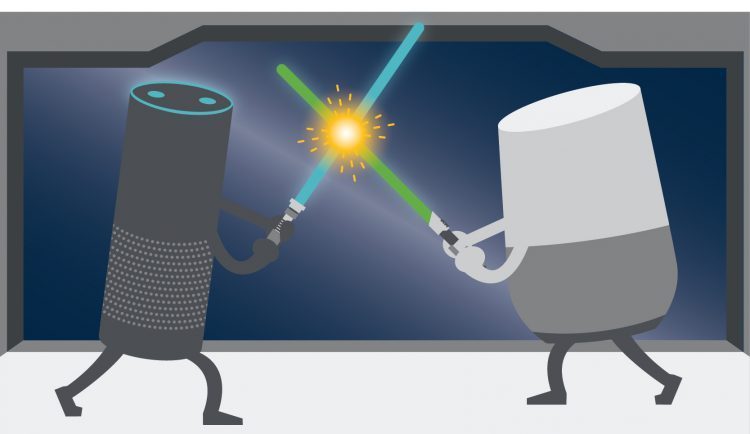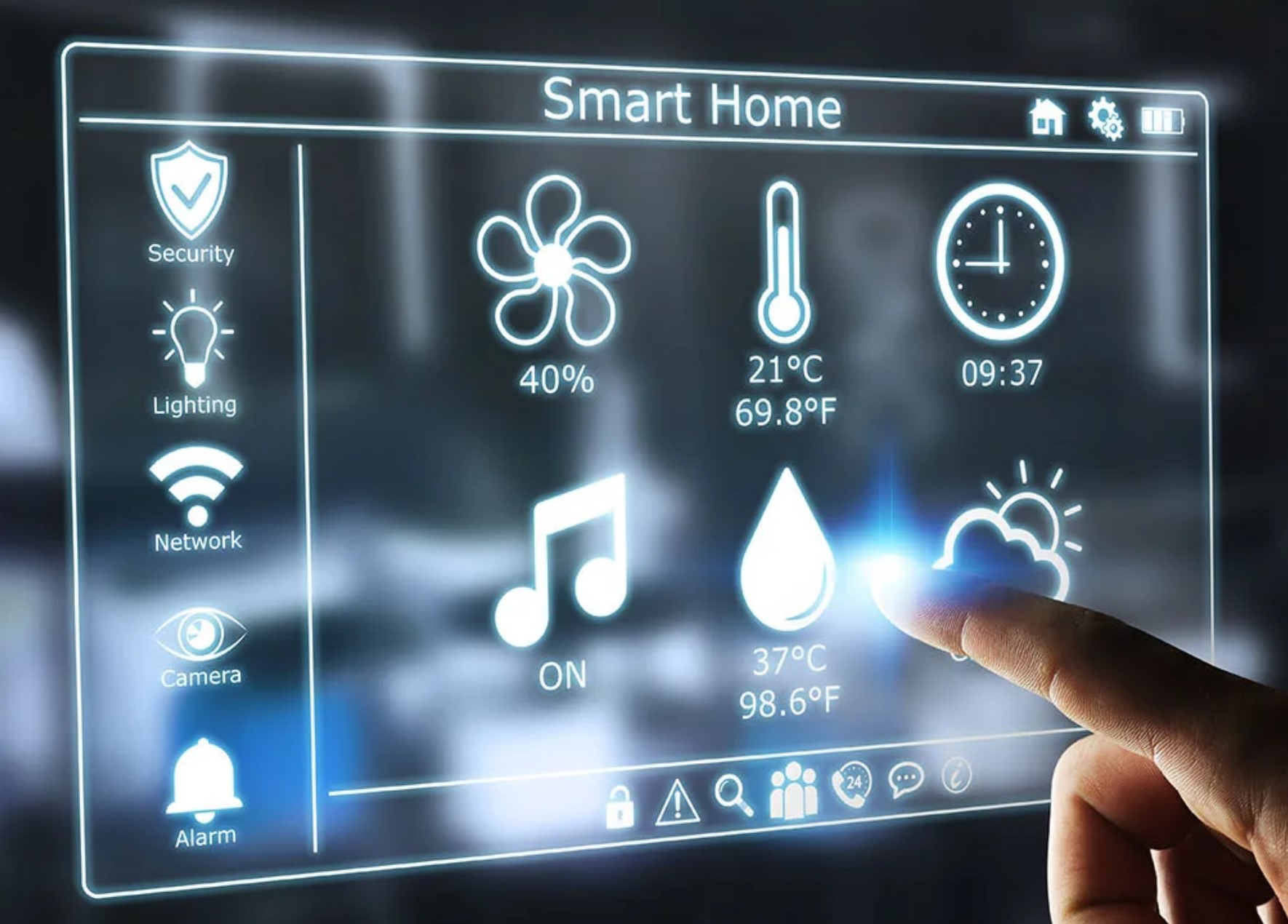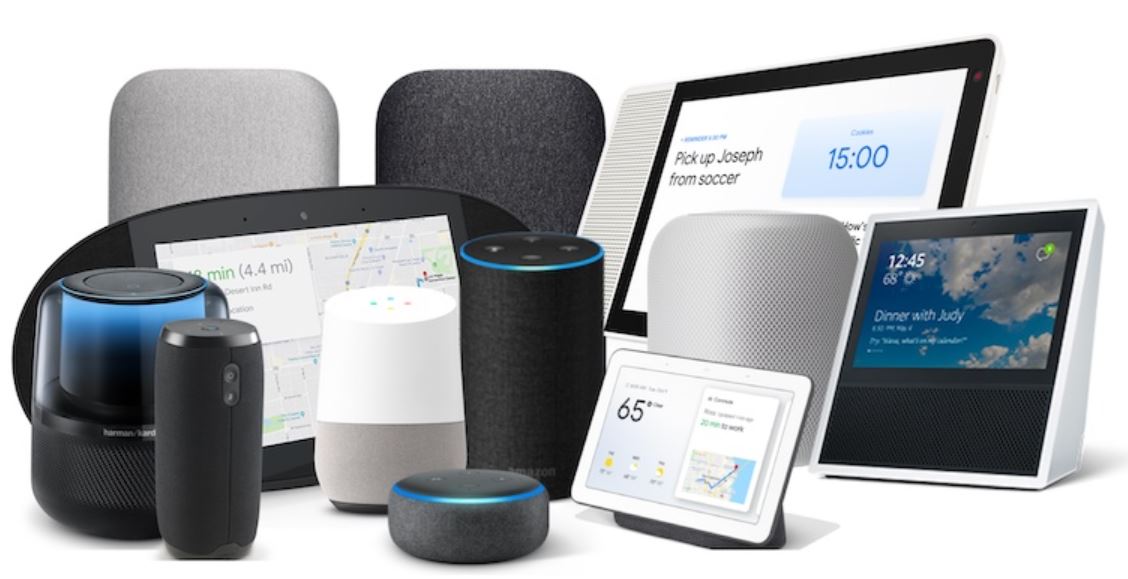There are two leading contenders for smart assistants – Google Assistant and Amazon Alexa. This guide presents the relative strengths/weaknesses, why or if you need one, privacy implications, and ecosystem suitability.
We are not looking at Samsung’s Bixby/SmartThings, LG’s ThinQ, Apple’s Siri/HomeKit or Microsoft Cortana – these are more device-specific and have a long way to match Google Google Assistant or Amazon Alexa.

What is Google Assistant or Amazon Alexa?
Most will think of the rather friendly voice assistants that you can ask for the time, the weather, a joke, or a question. In fact, a voice assistant is the same as a keyboard – you speak instead of typing your query.
That query goes up the internet to Google or Amazon artificial intelligence clouds, and a split second later, you get a verbal response. The clouds have high levels of machine learning – once you ask a unique question, its answer is globally available.
How do they answer a question?
The critical difference is the algorithms these clouds use to filter data (curate) and what resources they can access.
Google Assistant has the same access to Google Search resources as you do when doing a web search. It also has access to Google Maps, Translate, Lens and Google services. There can be hundreds, if not thousands, of search results.
Amazon Alexa uses Microsoft’s more limited Bing search engine, drawing on Wikipedia and Amazon-owned resources like IMDb (movie database).
Both use proprietary algorithms to filter the results and deliver what they determine is the best answer. That is frustrating as the curated answer is all you get, regardless of right or wrong. In a physical search using Google or Bing search engines, you at least see the results in order of relevancy.
What is relevancy?
A well-worn example is to ask both, “How much does a manicure cost?
Google Assistant replies, “On average, a basic manicure will cost you about $20. However, special types of manicures like acrylic, gel, shellac, and no-chip range from about $20 to $50. I can recommend some local salons if you wish.”
Alexa replies, “The top search result for a manicure is Beurer Electric Manicure and Pedicure Kit. It is $59 on Amazon. Want to buy it?”
In Google’s case, over 80% of its revenue comes from advertising, so it will drive you to, in this case, a local vendor that pays for Google AdWords and perhaps has positive reviews (accurate user reviews are vital).
In Amazon’s case, its revenue comes from making Amazon sales. It is bigger than the top 14 largest US retailers combined. It will drive you to products it thinks are suitable for you.


How do smart assistants know what is best for me?
You may not know it, but Amazon and Google (and companies like Facebook) know more about you than your mother!
They build a profile. Google focuses on demographics (age, gender), where you live, search history (including OK Google), sites you visit, etc. All this helps it direct ‘personalised advertising’ to you. Search for nappies, and it knows to deliver baby adverts.
Amazon does not have as much web search information. It focuses on your Amazon product searches, likes/dislikes, the information you provide, Alexa questions and gathers information from companies like Facebook that you may have logged in with (Never use a third-party login – use an email and password). While Amazon profiles may seem more limited, its products and services are so vast that they touch you in so many ways.
Both Amazon and Google AI are class-leading because they drive their revenue.
What do you do with a smart assistant?
Sadly, only a fraction of what they can do. The main use is to tell the time, weather forecast, answer relatively benign questions and find recipes or count calories.
Some have started to use them to listen to the radio (Google has TuneIn and Alexa has Commercial Radio Australia App) or stream music.
Google has Duo for free audio and video calls to mobiles and landlines, and Alexa has a similar feature.
You can read more about Google Assistant here and Alexa here. As we use so little of each’s features, you can be sure that both will fill basic needs.
Smart Home Hub
Google Assistant and Alexa can control the smart home hub of connected IoT devices like lights, security cameras, doorbells, thermostats, heaters/fans/purifiers, etc.
Such a device needs to be Google Assistant and/or Alexa capable, just as it would need HomeKit in Apple Siri’s world.
Again, statistics vary, but according to TechJury, Google supports 48% of IoT devices, Alexa at 37% and HomeKit at 12%.
A Smart Home depends on a strong, whole-of-home Wi-Fi service. Sales of Wi-Fi 6 and later routers are skyrocketing. See Seamless whole-of-home Wi-Fi now easy with Wi-Fi 6 (guide).
Smart Home also depends on adopting the industry-standard ‘Matter’. Google supports it both in Google Assistant and Android, and Alexa supports it. This means that both Assistants should be able to support all smart IoT devices.

Privacy – you give that up with all Smart Assistants
Let’s assume that anything you do on the internet is not private. Anything you say to Google Assistant or Amazon Alexa is just the same.
No matter what Google or Amazon say about privacy, their fundamental raison d’être is advertising (Google) or selling you something (Alexa). Both know that the average user will not read the privacy policies (Google Assistant and Alexa) nor access their Google or Amazon account to tighten security settings.
Both want to know as much about you under the guise of helping you more, and that means opening your call logs, contacts, search history and more to them. I shout the warning – do not invoke personalisation.
While both may claim not to sell personal data, that is very different to monetising it – there are rivers of minable gold nuggets in your data.

Australian situation – which is winning?
It is hard to put a number on Smart Assistant use, and figures for Australia are a little rubbery.
Every Android smartphone has an embedded Google Assistant as well as Android Auto, Android TV, Android Wear and more. Google Assistant is so far ahead of Alexa by sheer force of these numbers that there is no competition.
If we measure smart speaker sales, it depends on the specific country’s understanding of Amazon or Google. For example, Amazon Alexa leads in the USA (it had 70% market share in 2019 versus Google at 25% and Siri at 5%) because Amazon is a household word there. But the tide is apparently turning, and in 2021/22, it appears Alexa and Google are pretty much line ball. Amazon makes the bulk of Alexa speakers, with some from Ultimate Ears, Sonos and Lenovo.
In Australia, Amazon is not as well-known or trusted, so Google Assistant leads. Indicative 2021/22 figures put Google at 80%, Alexa at 15% and Siri at 5%. That is because companies like Sonos (that supports both Assistants), IKEA Symfonisk, Bose, JBL, Lenovo, LG, Yamaha, Sony, Samsung (Harman Kardon) and Google Nest produce Google Assistant speakers. Many of these also support Bluetooth Chromecast, the default Android audio and video casting.

The future?
Smart Assistant uptake via smart speakers, especially those with video screens, is snowballing. From launch in 2015 to now, we have 36% of US households with at least one. That figure is likely to be 50% within 12 months. Australians are not that far behind, with 100% penetration predicted by 2030.
But it is all about the future of voice taking over from typed keyboard commands, which is a no-brainer.
What to buy – Google Assistant or Amazon Alexa?
With no intention of bias, buy a Google Assistant speaker if you use an Android smartphone. If you use an iPhone, know that Siri/HomeKit barely registers a mere blip in the smart assistant feature set and smart home, so again, buy Google Assistant as iOS supports it.
It is not that Alexa lacks, and with Matter support, it may become a non-issue. It is about which FAANG (Facebook, Amazon, Apple, Netflix, Google) big tech company you trust. People are comfortable with Android or iOS, which makes me think it is a 2-horse race.
Update: Some relevant Australian figures, July 2021
Commercial Radio Australia sponsored the 32-page Smart Audio Report. It has a keen interest in where and how we consume audio content. Smart speakers have to potential to eat their lunch if not embraced.
- 26% own a smart speaker – that is around 5.6 million people. That is well up from 5% in 2018, 13% in 2019 and 17% in 2020. If this trend keeps growing exponentially, we will see 100% penetration well before 2030. We are not far behind the US at 33% – they had access to Amazon Alexa a year earlier than here.
- Interestingly the sales ratio of Google to Alexa here is 8:1. In the US, where Alexa was first, and Amazon is a household name, it is approx. 1:1. Google figures worldwide (except the US) show a considerable margin from underdog to 8:1 in just two years. BTW – Apple barely makes a blip on the stats.
- 55% own one speaker, and 45% own two or more. Retailers report that the first purchase is usually a Google Nest Mini at $49 to allow users to get a feel for what it does. The second purchase is typically a Google Nest Hub ($149 with a video screen for free Duo video telephone calls). Later purchases are for multi-room music, including Sonos 5 ($749 stereo), Sonos One ($299 usually sold in pairs for stereo), Sonos Roam ($279 mono portable) and Sonos Move ($649 transportable). Increasingly more people expect soundbars to be smart speakers.
- 55% place it in the living room, followed by 31% food prep, 29% main bedroom, 21% home office, 20% other bedrooms, and 11% bathroom (multiple speaker ownership). Retailers report that you quickly find other uses once you have found your ‘groove’.
- 63% don’t know the extent of what it can do. An awful lot (63%) use them to entertain kids.
- 67% use the speaker daily, and 49% say it has encouraged them to use the smartphone voice assistant.
- 65% use it for music. We don’t know if that is from streaming radio, streaming services like Spotify or even DLNA home music collections.
- 59/55/46% use it for weather/time/alarms
- 53% use it to answer general knowledge questions.
- 41% for news (usually a command that invokes the ABC summary).
- 61% will buy more speakers.
- 70% say it makes their life easier, and 41% would never go back to life without it.
Trust is a huge issue affecting what you do with smart speakers
62% trust that their information is secure. Overall, there is still a wariness that hackers, government and others could illegally listen to your conversations. In reality, that is a very low probability for either type.
In Australia, Google has far more trust than Amazon to the extent that it has never hidden its business model or its intentions – to make money and serve us simultaneously are complimentary.
By comparison, Amazon’s data collection is laser-focused on making you buy more. It also aggregates data from hundreds of sources to build a profile that knows things not even your mother knows.
Voice assistant shopping is in its infancy – at present, 33% have thought about it, and 28% have ordered a product. We venture mainly on the Alexa Platform that drives you to its products, “Want to buy that?”
But by far, the largest group do not consider voice shopping a necessity. Issues include needing to see the item before buying, ordering the wrong thing etc.








4 comments
neil cowin
i have apple home pod ie siri time and weather I subscribe to apple but i have to subscribe to apple music to get music and radio?
i am a amazon prime subscription if i get amazon hub do i have to subscribe again to get radio and music?
Ray Shaw
I am not an Apple user. As I understand it, AMAZON Prime includes TV and Music. Radio is via a free Alexa ap=p. https://www.amazon.com.au/gp/help/customer/display.html?nodeId=201910360
Karen Lee
Hi guys
I have a Lenovo smart clock with google assistant installed. The problem I have is that there is a big difference with the volume levels when listening to the radio. If you turn it down by one click it’s too soft, alternatively if you turn up the volume it’s too loud. Have you any suggestions? I reset it with the assistance of the technician but it hasn’t worked.
Thanks in advance!!
Ray Shaw
Factory reset your device (only Smart Clock) With the device powered on, press down both the volume+ / volume- button for 10 seconds. Follow the on-screen instructions to set up your device. Once you have done that use your voice to set the volume – not a slider. Start by saying OK Google set the volume at 50%. That is all I can find on this.